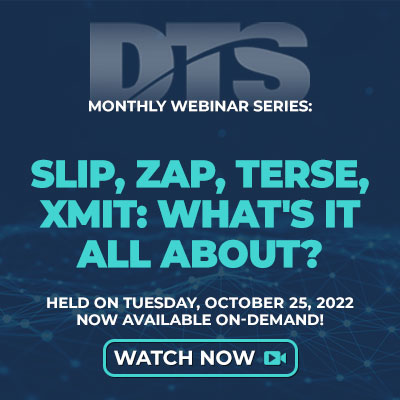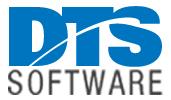DTS Webinar Recap: SLIP, ZAP, Terse, XMIT: What’s It All About?
As a pioneer, thought leader, and recognized authority in z/OS storage management, DTS Software is committed to the advancement and permanence of the mainframe ecosystem. One of the ways we contribute to the collective mainframe knowledge base is with our monthly, complimentary educational webinar series.
We strongly believe the transfer of knowledge from experienced mainframers to the new generation is critical. As the current generation moves on, and with the well-documented hiring gap, a tremendous amount of know-how gained from years of hands-on experience is potentially lost. Some of which the books can’t (or no longer) teach.
Debugging and Maintenance Tools
Whether new to the z/OS® system programming game or an experienced administrator in other platforms, programmers sometimes struggle to understand how some specialized z/OS systems utilities work or even what they’re used for.
In a recent webinar, now available on-demand, DTS CTO Steve Pryor examined some of the most common z/OS debugging and maintenance tools (specific to the IBM environment) and their typical use in problem-solving and repair.
In this webinar, Pryor stepped through the process of information gathering (SLIP and DUMP), transmitting data to support personnel (AMATERSE and TSO XMIT/RECEIVE), and examining files and applying fixes (AMASPZAP).
Problem-Solving Skills Are Your Foundation for Success
One of the most important tasks any system programmer does is problem-solving: identifying the problem and making recommendations for how to fix it. But what are the most widely used debugging tools and how are they put to use?
Whether the problem is inherent in the code or caused by something operational, typically when talking about debugging, we’re talking about dumps. These are most often in the form of symptom dumps, but other types of analytical data (SLIPs or activity traces) can come into play.
An in-depth discussion ensues.
Knowing What to do With the Data
Once the analytical data has been compiled, solving the problem may be as easy as referencing an error message or abend code in the Messages and Codes manual. There are several digital resources available to speed up that process, and Pryor discusses those as well.
Solving the problem might require sending the data to your ISV for an answer and it could require sending the data to IBM for assistance.
Real-World Examples and Additional Resources
It’s no secret that learning by example is a proven methodology. Pryor’s webinars always include real-world, on-screen examples of the topic, and he once again delivers.
As he does with each webinar, Pryor provides information on key reference resources available for those who need it. Steve also makes himself available as an additional resource and can be reached at steve@dtssoftware.com.
 Learn More in Our Webinar Available On-Demand
Learn More in Our Webinar Available On-Demand
“SLIP, ZAP, Terse, XMIT: What’s It All About?” is a 60-minute informative and educational look at an important topic in the mainframe space. It includes numerous examples, how-to guides, and information on where to find manuals on the subject should more in-depth problem-solving material be required.
If you weren’t able to attend or would like to review the material presented, you can view it on-demand and download a copy of the slide deck by using this link. Be sure to join us each month for our complimentary webinar series. Go to www.dtssoftware.com/webinars for more information.

